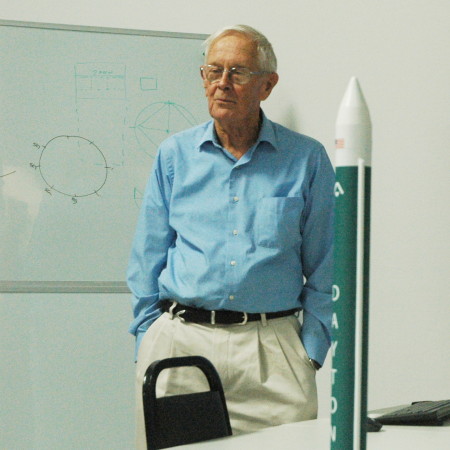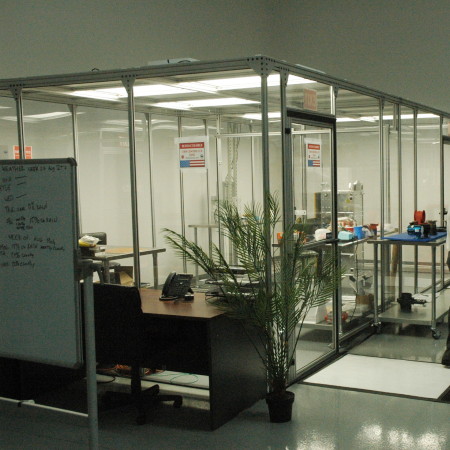A return to Phantom and the reminiscences of an Apollo astronaut

Charles Duke, Apollo 16 astronaut
Yesterday I had to pleasure of getting my second tour of the Phantom Space facilities, located here in Tucson. Jim Cantrell, the founder of the Tucson-based rocket/satellite company Phantom Space, had last week graciously invited me to attend the event he was holding there, where astronaut Charles Duke, from the April 1972 Apollo 16 lunar landing, would be giving a talk to the company’s employees, investors, and customers. Duke had become an advisor for the company, and this would be his first visit to its operations.
First, the talk by Charles Duke, describing his life and Apollo 16 walk on the Moon, was as usual awe-inspiring, mostly because Duke spoke like every astronaut I’ve ever met so matter-of-factly about what he had done. During the second of three excusions on the surface with his commander John Young, they drove their rover up the slope of nearby Stone Mountain, climbing to an elevation of 500 feet, the highest any human has so far been on the lunar surface. From there he could look back and see for miles, including the entire valley where the lunar module was nestled as well as the mountains and craters that surrounded it.
When I asked him if he had had any sense of his remoteness from humanity, his response was a good-natured laugh. “We felt at home there!” They had done so much study of the terrain beforehand, including simulations, that from the moment they approached to land it all looked very familiar. This is where they were supposed to be!
Following Duke’s presentation we all were given a tour of the facility. My first visit there had been in 2022. At the time Cantrell’s effort was to aggressively succeed from his earlier failure at the rocket startup Vector, focusing this new company on building its Daytona rocket. After the tour I concluded as follows:
Will Phantom succeed? Like all rocket startups, it is dangerous as an outsider to get too enthusiastic. However, the differences I noticed between Phantom and Vector I think bode well for its future.
The new tour confirmed to me the great challenges faced by all rocket startups, and why enthusiasm must always be tempered with realism. As I have noted in many recent reports on Behind the Black and Cantrell himself confirmed, the last two years have been very difficult for the rocket startup industry, especially the newer players like Phantom. The failures of the first round of startups such as Astra, Relativity, ABL, and Vector seriously cooled the enthusiasm of the investment community in spending money on new rockets. Though Phantom has raised $37 million in private capital, it has also been forced to cut back and slow its work.

It also found that the investment community was become more interested in supporting new satellite endeavours instead of rockets, so in response Phantom has shifted its focus to building satellites. The picture to the right shows the small clean room they now use to assemble satellites. This had not existed in 2022. Their goal is to use the synergy of their rocket as well as their planned constellation of satellites to maximize profits from both, much as SpaceX has done with its Falcon 9 and Starlink satellites.
Though Cantrell did not consider the increased regulatory burdens imposed by the federal bureaucracy on rockets since the start of the Biden administration as a major problem, I suspect it is another reason investment has dried up. If new rockets can’t launch because of red tape, investors don’t see any successes. This sends their money elsewhere.
It remains unknown whether Phantom will succeed. As Cantrell noted, “We have survived.” The company still hopes to launch its Daytona rocket in 2026. The rocket’s flight tanks have been qualified. So have its upper stage engines, provided by the company Ursa Major. The first stage engines, provided by the company Vast, are undergoing qualification now.
As I noted, Cantrell does not seem to be the kind of guy to give up. This story is not over, for sure.
On Christmas Eve 1968 three Americans became the first humans to visit another world. What they did to celebrate was unexpected and profound, and will be remembered throughout all human history. Genesis: the Story of Apollo 8, Robert Zimmerman's classic history of humanity's first journey to another world, tells that story, and it is now available as both an ebook and an audiobook, both with a foreword by Valerie Anders and a new introduction by Robert Zimmerman.
The print edition can be purchased at Amazon or from any other book seller. If you want an autographed copy the price is $60 for the hardback and $45 for the paperback, plus $8 shipping for each. Go here for purchasing details. The ebook is available everywhere for $5.99 (before discount) at amazon, or direct from my ebook publisher, ebookit. If you buy it from ebookit you don't support the big tech companies and the author gets a bigger cut much sooner.
The audiobook is also available at all these vendors, and is also free with a 30-day trial membership to Audible.
"Not simply about one mission, [Genesis] is also the history of America's quest for the moon... Zimmerman has done a masterful job of tying disparate events together into a solid account of one of America's greatest human triumphs."--San Antonio Express-News


“First, the talk by Charles Duke, describing his life and Apollo 16 walk on the Moon, was as usual awe-inspiring, mostly because Duke spoke like every astronaut I’ve ever met so matter-of-factly about what he had done. During the second of three excusions on the surface with his commander John Young, they drove their rover up the slope of nearby Stone Mountain, climbing to an elevation of 500 feet, the highest any human has so far been on the lunar surface. From there he could look back and see for miles, including the entire valley where the lunar module was nestled as well as the mountains and craters that surrounded it.”
I wonder if Charles took a photo of that scene, looking down at that valley, or is there an official NASA photo of that somewhere. I have never seen one my self, but it would be a cool one.
Cantrell faces the same problems the VLJ/Air- taxi people faced…VC tightwads who would rather fund computer start-ups with low overhead. They avoid aerospace like the plague.
It doesn’t matter what the name of the company.
Oh, and for Pete’s sake Mr. Z….never use the word “synergy” again.
That’s right down there with “vape enthusiast” and “carbon-neutral.”